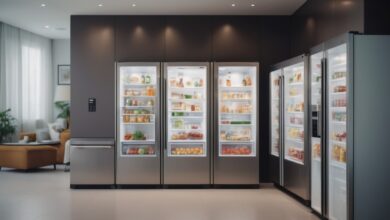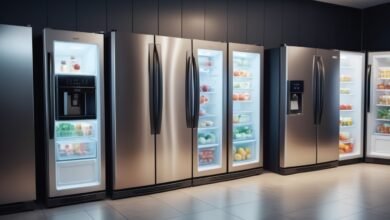Crafting an Eco-Friendly Kitchen: The Ultimate Guide to Green Refrigerators

Creating an environmentally conscious kitchen involves more than just selecting aesthetically pleasing appliances. With sustainability at the forefront of today’s lifestyle choices, the focus shifts towards green kitchen appliances, and in this comprehensive guide, we’ll delve into the realm of refrigerators. Understanding the criteria for being green and energy-efficient, exploring innovative technologies, and highlighting top models from leading brands will empower you to make informed decisions for a greener and more sustainable kitchen.
The Criteria for Green and Energy-Efficient Refrigerators
Before delving into specific models, let’s establish the criteria that define green and energy-efficient refrigerators. These criteria serve as benchmarks for environmentally friendly appliances:
1. Energy Star Certification:
One of the primary indicators of a green refrigerator is the Energy Star certification. This label, issued by the U.S. Environmental Protection Agency (EPA), signifies that the appliance meets or exceeds strict energy efficiency guidelines. Energy Star-certified refrigerators consume less energy, contributing to both cost savings for the consumer and a reduced environmental impact.
2. Inverter Compressors:
The heart of any refrigerator is its compressor, and green models often feature inverter compressors. Unlike traditional compressors that turn on and off to maintain the desired temperature, inverter compressors operate continuously but adjust their speed based on cooling demands. This results in more consistent temperatures, significant energy savings, and quieter operation.
3. Advanced Insulation Materials:
The insulation within a refrigerator is critical for maintaining cool temperatures efficiently. Green models incorporate advanced insulation materials, such as polyurethane foam or vacuum insulation panels. These materials improve thermal efficiency, reduce the workload on the compressor, and contribute to overall energy savings.
4. Smart Temperature Control:
Smart temperature control systems utilize sensors to monitor and adjust the internal temperature based on the contents of the refrigerator. This technology ensures optimal conditions for food storage while minimizing unnecessary energy consumption. The ability to adapt to real-time conditions distinguishes green refrigerators from their conventional counterparts.
5. Adaptive Defrost Technology:
Traditional refrigerators follow fixed defrost cycles, which can be energy-intensive. Green models often feature adaptive defrost technology, adjusting the defrosting frequency based on the actual need. This not only reduces energy consumption but also enhances the efficiency of the appliance.
6. LED Lighting:
Energy-efficient lighting is another hallmark of green refrigerators. LED lighting, now a standard feature in many models, not only provides bright and efficient illumination but also minimizes heat generation. This dual benefit contributes to overall energy efficiency.
Exploring Innovative Technologies in Green Refrigerators
Now that we’ve established the criteria for being green and energy-efficient, let’s take a closer look at some of the innovative technologies that make these appliances environmentally friendly:
1. Inverter Compressors:
As mentioned earlier, inverter compressors are a game-changer in the world of refrigeration. These compressors operate more efficiently by adjusting their speed based on the cooling needs of the refrigerator. This results in energy savings and a more consistent and stable internal temperature.
2. Triple Cooling Systems:
Some advanced green models feature triple cooling systems that independently control the temperature in the refrigerator and freezer compartments. This not only optimizes energy usage but also helps preserve the freshness of food for longer periods.
3. Smart Temperature Control:
Smart temperature control systems use sensors to monitor the contents of the refrigerator and adjust the internal temperature accordingly. This ensures that the appliance operates at its most energy-efficient levels while keeping food at the optimal storage temperature.
4. Vacuum Insulation Panels:
Innovative insulation materials, such as vacuum insulation panels, are increasingly being incorporated into green refrigerators. These panels offer superior insulation properties compared to traditional materials, reducing the workload on the refrigerator’s cooling system.
5. Solar-Powered Refrigerators:
Some green refrigerators take sustainability a step further by incorporating solar panels. These models harness renewable energy from the sun to power the refrigerator, making them an excellent choice for regions with ample sunlight and a commitment to eco-friendly living.
Top Green Refrigerators: Leading the Sustainable Kitchen Revolution
Now, let’s explore some of the top green refrigerators available in the market. These models exemplify the criteria for being green and energy-efficient, representing the forefront of environmentally conscious refrigeration:
1. LG InstaView Door-in-Door Refrigerator
Overview:
LG’s InstaView Door-in-Door Refrigerator is a blend of innovation and sustainability. The InstaView feature allows you to see inside the refrigerator without opening the door, reducing unnecessary cold air loss.
Key Green Features:
- Inverter Linear Compressor: Adjusts its speed based on cooling demands, enhancing energy efficiency.
- Energy Star Certification: Meets strict energy efficiency guidelines.
2. Samsung Family Hub Refrigerator
Overview:
Samsung’s Family Hub Refrigerator transcends traditional refrigeration. It serves as a smart hub for your kitchen, with an energy-efficient design and innovative features.
Key Green Features:
- Digital Inverter Compressor: Optimizes energy efficiency by adjusting its speed.
- Smart Connectivity: Allows you to monitor and control the refrigerator remotely.
3. Whirlpool French Door Refrigerator with Accu-Chill™ Technology
Overview:
Whirlpool’s French Door Refrigerator with Accu-Chill™ Technology is engineered for precise temperature control, ensuring optimal conditions for food storage.
Key Green Features:
- Accu-Chill™ Temperature Management System: Adapts to environmental conditions, reducing energy waste.
- Energy Star Certification: Meets strict energy efficiency standards.
4. GE Profile French Door Refrigerator with Keurig® K-Cup® Brewing System
Overview:
GE Profile’s French Door Refrigerator seamlessly integrates convenience with energy efficiency. The inclusion of a Keurig® K-Cup® Brewing System adds an extra layer of functionality.
Key Green Features:
- TwinChill™ Evaporators: Enhances freshness while minimizing energy consumption.
- Eco-Friendly Insulation: Utilizes sustainable insulation materials.
5. Bosch Counter-Depth Refrigerator with VitaFreshPro™ Technology
Overview:
Bosch, renowned for precision engineering, offers a counter-depth refrigerator with VitaFreshPro™ Technology for optimal food preservation.
Key Green Features:
- VitaFreshPro™ Technology: Maintains optimal temperature and humidity, reducing energy waste.
- Energy Star Certification: Meets stringent energy efficiency standards.
6. KitchenAid Multi-Door Freestanding Refrigerator
Overview:
KitchenAid’s Multi-Door Freestanding Refrigerator combines luxurious design with energy-efficient features. The Preserva® Food Care System ensures optimal storage conditions.
Key Green Features:
- Preserva® Food Care System: Dual evaporators for precise temperature and humidity control.
- LED Lighting: Efficient illumination with minimal energy consumption.
Choosing the Right Green Refrigerator: A Buyer’s Guide
Selecting a green refrigerator involves considering various factors to ensure it aligns with your sustainability goals. Here’s a comprehensive buyer’s guide to assist you in making an informed decision:
1. Energy Star Certification:
Prioritize refrigerators
with the Energy Star label, indicating compliance with strict energy efficiency guidelines set by the EPA. This certification is a reliable indicator of a green and energy-efficient appliance.
2. Inverter Compressors:
Look for models with inverter compressors for their ability to adjust speed based on cooling demands. This feature provides energy savings and more consistent temperatures.
3. Size and Layout:
Choose a refrigerator size and layout that aligns with your household needs. A well-sized refrigerator ensures efficient cooling without unnecessary energy consumption.
4. Advanced Insulation:
Check for models with advanced insulation materials, such as vacuum insulation panels, to enhance thermal efficiency and reduce energy consumption.
5. Smart Temperature Control Systems:
Opt for refrigerators with smart temperature control systems that adjust internal temperatures based on the contents, minimizing unnecessary energy usage.
6. Convertible Features:
Consider models with convertible features that allow you to adapt storage space based on your needs. This flexibility contributes to efficient energy usage.
7. User Reviews:
Read user reviews to gain insights into the real-world energy efficiency and performance of the refrigerator model you are considering. Real experiences can provide valuable information for your decision-making process.
8. Life Cycle Assessment:
Consider the environmental impact over the entire life cycle of the refrigerator, including manufacturing, transportation, use, and disposal. Some brands provide detailed information about their sustainability practices.
9. Warranty and Service:
Check the warranty and available service options for the refrigerator. A longer warranty period and reliable service can contribute to the longevity of the appliance, reducing the need for premature replacements.
10. Price vs. Long-Term Savings:
While green refrigerators may have a higher upfront cost, consider the long-term savings in energy bills. Calculate the payback period for the energy-efficient features to evaluate the economic benefits over time.
Conclusion
In the pursuit of a sustainable and eco-friendly kitchen, choosing a green refrigerator is a crucial step. The models highlighted in this guide, including those from LG, Samsung, Whirlpool, GE Profile, Bosch, and KitchenAid, showcase a range of features and designs that cater to different preferences and needs while prioritizing sustainability.
By understanding the criteria for being green and energy-efficient, exploring innovative technologies, considering key factors in the buyer’s guide, and reading user reviews, you can transform your kitchen into a haven of eco-conscious living. As manufacturers continue to innovate in response to growing environmental awareness, the future holds the promise of even more energy-efficient and eco-friendly refrigeration options. Make your kitchen a testament to sustainability, contributing to a greener planet with every cooling cycle.






